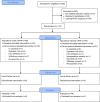Comparing the effects of continuous positive airway pressure via mask or helmet interface on oxygenation and pulmonary complications after major abdominal surgery: a randomized trial
- PMID: 35429325
- PMCID: PMC9013185
- DOI: 10.1007/s10877-022-00857-7
Comparing the effects of continuous positive airway pressure via mask or helmet interface on oxygenation and pulmonary complications after major abdominal surgery: a randomized trial
Abstract
The risk of pulmonary complications is high after major abdominal surgery but may be reduced by prophylactic postoperative noninvasive ventilation using continuous positive airway pressure (CPAP). This study compared the effects of intermittent mask CPAP (ICPAP) and continuous helmet CPAP (HCPAP) on oxygenation and the risk of pulmonary complications following major abdominal surgery. Patients undergoing open abdominal aortic aneurysm repair or pancreaticoduodenectomy were randomized (1:1) to either postoperative ICPAP or HCPAP. Oxygenation was evaluated as the partial pressure of oxygen in arterial blood fraction of inspired oxygen ratio (PaO2/FIO2) at 6 h, 12 h, and 18 h postoperatively. Pulmonary complications were defined as X-ray verified pneumonia/atelectasis, clinical signs of pneumonia, or supplementary oxygen beyond postoperative day 3. Patient-reported comfort during CPAP treatment was also evaluated. In total, 96 patients (ICPAP, n = 48; HCPAP, n = 48) were included, and the type of surgical procedure were evenly distributed between the groups. Oxygenation did not differ between the groups by 6 h, 12 h, or 18 h postoperatively (p = 0.1, 0.08, and 0.67, respectively). Nor was there any difference in X-ray verified pneumonia/atelectasis (p = 0.40) or supplementary oxygen beyond postoperative day 3 (p = 0.53). Clinical signs of pneumonia tended to be more frequent in the ICPAP group (p = 0.06), yet the difference was not statistically significant. Comfort scores were similar in both groups (p = 0.43), although a sensation of claustrophobia during treatment was only experienced in the HCPAP group (11% vs. 0%, p = 0.03). Compared with ICPAP, using HCPAP was associated with similar oxygenation (i.e., PaO2/FIO2 ratio) and a similar risk of pulmonary complications. However, HCPAP treatment was associated with a higher sensation of claustrophobia.
Trial registration: ClinicalTrials.gov NCT02173327.
Keywords: Continuous positive airway pressure; Helmet CPAP; Mask CPAP; Noninvasive ventilation; Pneumonia; Repiratory therapy.
© 2022. The Author(s), under exclusive licence to Springer Nature B.V.
Conflict of interest statement
The authors have no financial or non-financial interest to disclose.
Figures
Comment in
-
Comparing helmet with mask CPAP following major abdominal surgery.J Clin Monit Comput. 2023 Feb;37(1):19-20. doi: 10.1007/s10877-022-00895-1. Epub 2022 Jul 10. J Clin Monit Comput. 2023. PMID: 35816259 No abstract available.
References
-
- Jammer I, Wickboldt N, Sander M, et al. Standards for definitions and use of outcome measures for clinical effectiveness research in perioperative medicine: European Perioperative Clinical Outcome (EPCO) definitions: a statement from the ESA-ESICM joint taskforce on perioperative outcome measur. Eur J Anaesthesiol. 2015;32(2):88–105. doi: 10.1097/EJA.0000000000000118. - DOI - PubMed
-
- Ireland CJ, Chapman TM, Mathew SF, Herbison GP, Zacharias M. Continuous positive airway pressure (CPAP) during the postoperative period for prevention of postoperative morbidity and mortality following major abdominal surgery. Cochrane Database Syst Rev. 2014 doi: 10.1002/14651858.CD008930.pub2. - DOI - PMC - PubMed
Publication types
MeSH terms
Substances
Associated data
Grants and funding
LinkOut - more resources
Full Text Sources
Medical


